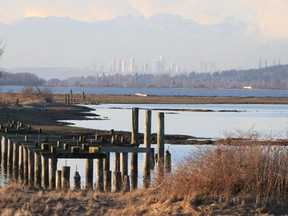Opinion: The cost to conserve or restore an already functioning landscape is often much lower than the cost of recreating those ecosystem services anew.

Article content
It probably is no surprise that a survey commissioned last year by the Fraser River Delta Farmland Protection and Stewardship Working Group, a collaboration of representatives from local municipalities, academia, environmental non-profits and the federal government, found a broadly positive sentiment on behalf of residents of Lower Mainland B.C. toward local natural spaces.
Advertisement 2
Article content
Sixty-one per cent of just over a thousand local survey respondents indicated these spaces contributed to their personal sense of well-being and agreed that challenges like food security are improved by the existence of healthy ecosystems and farmland where pollinators can thrive, salmon can spawn, and birds can rest and nest, allowing our food sources to flourish.
Article content
Perhaps what is a surprise is that 82 per cent of those surveyed thought that nature was worth investing in, with 74 per cent supporting helping local farmers restore and protect key habitats.
With today’s cost-of-living pressures, it’s notable and reassuring that we can still see a big-picture solution to protect threatened ecosystems and food systems, and work toward it.
Article content
Advertisement 3
Article content
Natural environments and agricultural lands need to be conserved to combat the pressures of development, and cultivate resilience to climate change, and this need is both urgent and necessary.
Pressures on natural spaces continue to increase, with expansion encroaching on the landscapes surrounding our urban centres — for example, over 85 per cent of wetland habitats have already been lost to other land uses in the most populated parts of the province like the South Coast and the Okanagan.
Natural spaces provide what experts call “ecosystem services,” which can be challenging to quantify but are critical to the healthy balance and resilience of a landscape. Wetlands, for example, store water during heavy rains mitigating floods, and release water during dry periods to alleviate drought. They filter water and sequester carbon, they combat erosion and mitigate wildfires, and contribute to positive mental-health and cultural experiences for people.
Advertisement 4
Article content
As these ecosystem services are lost, the need for them remains, and must be replaced by costly alternatives. When they’re not replaced, we can all pay the price when floods, droughts and fires ravage houses, businesses, farms and ranches.
Conservation finance is increasingly recognized as a key part of the solution to the crisis facing the ecosystem services we rely on. For example, on Oct. 26, 2023, the province announced a $300 million investment in a Conservation Financing Mechanism specifically earmarked for projects to be completed in partnership with First Nations communities.
Different solutions can work together, and a local conservation fund provided through government can be used to support environmental conservation and community sustainability projects. These funds can be managed locally, meaning the projects and their benefits positively impact the regions that the funds are drawn from.
Advertisement 5
Article content
Oftentimes, the cost to conserve or restore an already functioning landscape is much lower than the cost of recreating those ecosystem services anew, so fund contributors can ultimately pay less for the services needed in their region.
The Regional District of Central Kootenay, for example, established a conservation fund in 2014 when residents voted in favour of its creation, and since then, funds have been collected through a parcel tax — where a fixed dollar amount or percentage of assessed land value is charged to the owner of a piece of land.
For the Regional District of Central Kootenay, $15 per parcel per year is collected and used to invest in local projects like invasive species monitoring and removal, wetland enhancement, ecosystem restoration and other initiatives. Between 2016 and 2022 the Regional District of Central Kootenay funded 44 grants totalling $535,000.
Advertisement 6
Article content
As our climate changes and our population grows, our local ecosystems feel pressure from development, invasive species and natural disasters. Investments in nature ensure we protect these critical spaces so the ecological benefits can be enjoyed long into the future.
Matt Christensen is head of the B.C. Conservation Programs from Ducks Unlimited Canada, on behalf of the Fraser River Delta Farmland Protection and Stewardship Working Group.
Recommended from Editorial
Bookmark our website and support our journalism: Don’t miss the news you need to know — add VancouverSun.com and TheProvince.com to your bookmarks and sign up for our newsletters here.
You can also support our journalism by becoming a digital subscriber: For just $14 a month, you can get unlimited access to The Vancouver Sun, The Province, National Post and 13 other Canadian news sites. Support us by subscribing today: The Vancouver Sun | The Province.
Article content
reference: theprovince.com


